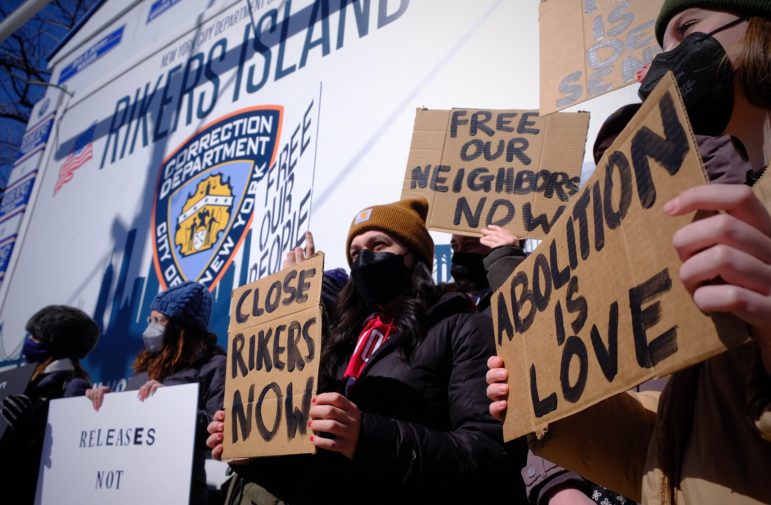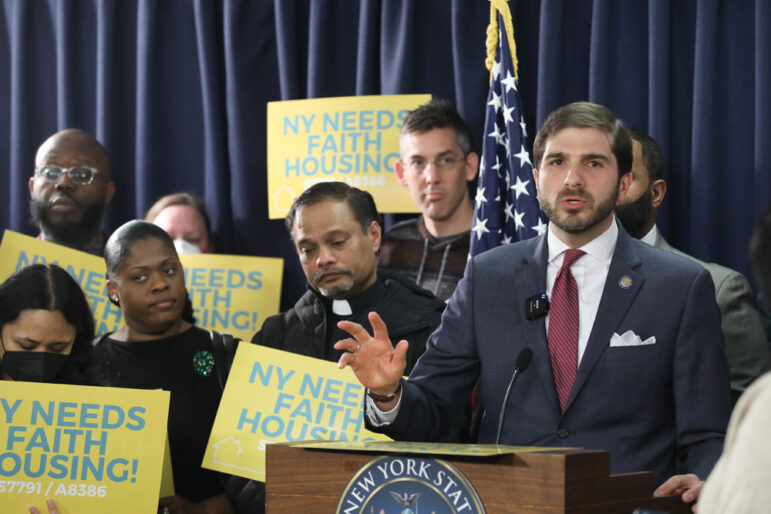“When the state takes away a person’s liberty, it bears a serious obligation to provide them proper care, and the built environment is a big part of that. Cutting our jail population significantly and overhauling the material conditions that people live in will be a massive victory.”

Gerardo Romo/NYC Council
Protestors hold signs calling for the closure of Rikers Island jails at a rally in 2019.Last fall, I attended a community design guidelines meeting for the Manhattan borough-based jail that will replace “the Tombs” as part of the plan to close Rikers. At the time, my nephew had just been transferred upstate after spending two hellish years on Rikers Island. For me, my sisters, and my mom, that also meant two hellish years struggling to support him in an environment that was designed to banish him out of sight and disconnect him from his community. As someone who knows the strain that Rikers puts on families, and as an organizer with Freedom Agenda working to shut it down, I knew that I had the exact insights needed to shape this design process.
Unfortunately, I didn’t get to do that. Instead, I was subjected to hours of people shouting that the replacement jail shouldn’t be built at all. They complained about noise, costs, parking, and sometimes very openly about the people who would be held there and people, like me, who would visit them. Some people expressed outrage over the Department of Correction’s failure to keep trees outside The Tombs alive, but made no mention of the dozens of people who have died on Rikers Island since 2021.
At one point a graduate student sitting in front of me, who later told me she was an abolitionist, rolled her eyes and said mockingly, “Oh how nice, you’re gonna make a visiting room…in a jail.” I thought about the multiple buses and hours-long wait I had to endure to sit in a cramped, decrepit Rikers visiting room and look at my nephew through glass so scratched I could barely see him.
While the audience at the design session seemed to include both people who were content to let Black and brown folks keep dying on Rikers Island and a few who presented themselves as advocates for us, the effect was the same—I was completely silenced. I expected the city to make it difficult for people with lived experience to be heard in this process, but that night my fellow New Yorkers were actually a bigger barrier to participation.
I’m a staunch advocate for closing Rikers, and for the borough jails. Let me explain why. The first and most important is that this is a plan to shrink incarceration, from 14 jails to four. Any misconceptions about that should have been resolved by the fact that our lock-em-up mayor frequently complains that the borough jails will hold too few people for his liking and tries at every turn to delay their construction.
Thankfully, other city leaders have shown a firm understanding that reducing incarceration, while investing in alternatives, will increase safety, not jeopardize it, and are resisting Mayor Eric Adams’ efforts to derail this plan and fill up Rikers. People who talk about the borough jail plan as an expansion are either deliberately lying, or they’re revealing how invisible the sprawling capacity of Rikers is to them.
Incarceration is inherently harmful, so reducing it is the most important way to reduce that harm. But it’s not enough. As long as anyone is still incarcerated, conditions of confinement matter.
When people arrive at Rikers now, they first go through intake areas that are nothing more than a massive cage, where people have to sit on the floor next to broken toilets, with mice and roaches crawling over them. Then they’re transferred to dank housing areas that are stifling in the summer and frigid in the winter, with communal showers and plumbing so faulty that sometimes raw sewage leaks into their cells and dayrooms.
Even constant repairs can’t fix this, since the Rikers jails are largely built on decomposing trash. The ground shifts as it settles and causes cracks in the buildings, and also exposes people on the island to leaking methane. If you’ve never been deprived of your liberty, you might forget how much small things in your environment matter. But I know being able to shower in an individual stall, look out an actual window in a space that doesn’t stink, and access to clinic and recreation spaces directly instead of relying on guards for transport would all have been transformative for my nephew’s physical and mental well-being. Not to mention being close enough for us to come for a quick visit after work, instead of only when we could put aside a half-day.
Creating these transformed conditions via the borough jails won’t be cheap, but cheap isn’t the goal. The goal is, first, for incarceration to be as limited as possible, and, second, as responsible as possible. When the state takes away a person’s liberty, it bears a serious obligation to provide them proper care, and the built environment is a big part of that. Cutting our jail population significantly and overhauling the material conditions that people live in will be a massive victory.
And we’ll still have a lot of work to do. The Department of Correction’s corruption is well-known, and the work to uproot it is ongoing. But I can guarantee you that everyone who is actually invested in doing something about that knows that every step of that work will be made easier when DOC no longer enjoys the privilege of operating a 400-acre penal colony hidden from public view.
Personally, I won’t be fully satisfied until all of our people are free. As a Native New Yorker and Puerto Rican woman raised in pre-gentrification Jackson Heights by a single mother, I have seen how disinvestment combined with criminalization has stolen so much from my community and the people I love. I desperately want our society to get to a place where we can make prisons and jails obsolete. But I know that while we tackle the long-term work of undoing these entrenched systems of oppression, we also have to do everything we can to ease the suffering of the people dealing with their impacts here and now.
It comes down to this: if you believe that a plan to close Rikers is acceptable only if it inconveniences no one, costs nothing, and solves every problem with the criminal legal system in one fell swoop, then no plan will ever suffice and we’ll end up with…Rikers. I won’t accept that, and no one else should either.
The borough jail designs are not yet finalized and we cannot waste the opportunities that exist right now to shape this plan for the better—for example, pushing back on the mayor’s plan to add beds and reduce therapeutic housing units in the process. Not everyone will want to participate in this design process, but I hope they at least won’t stand in the way of letting me and other impacted people do so.
Ashley Abadia-Santiago Conrad is a senior community organizer with Freedom Agenda.








